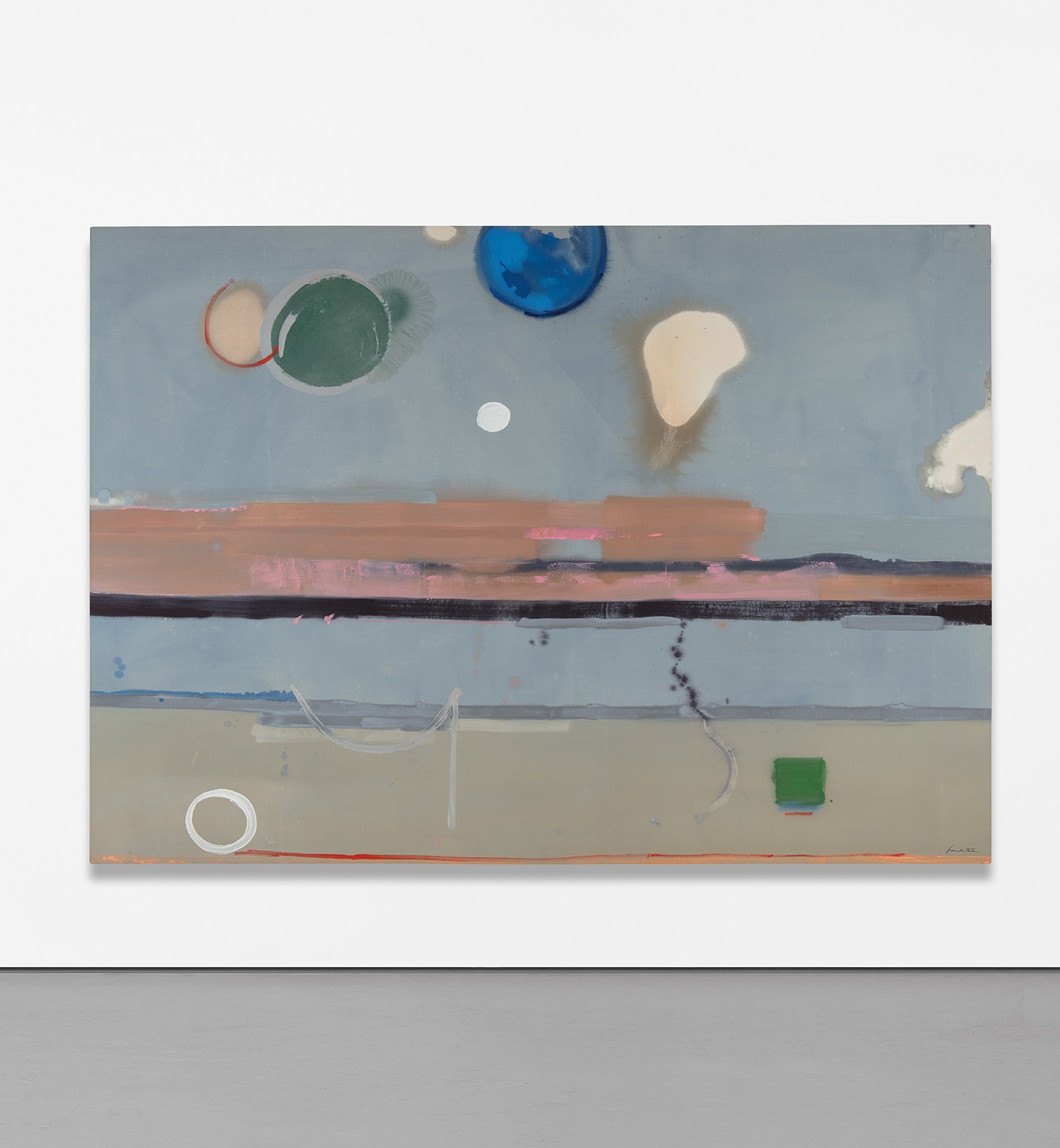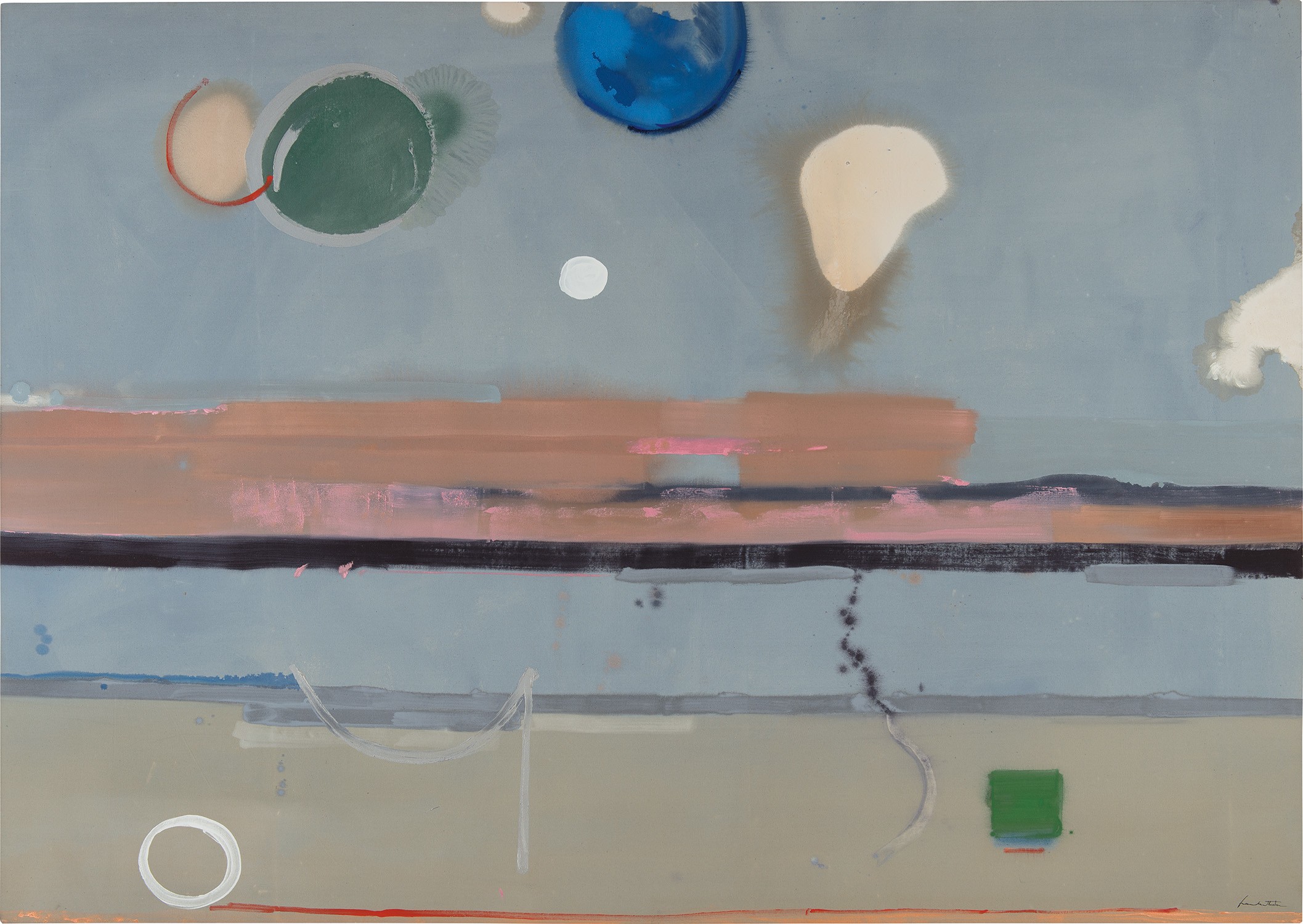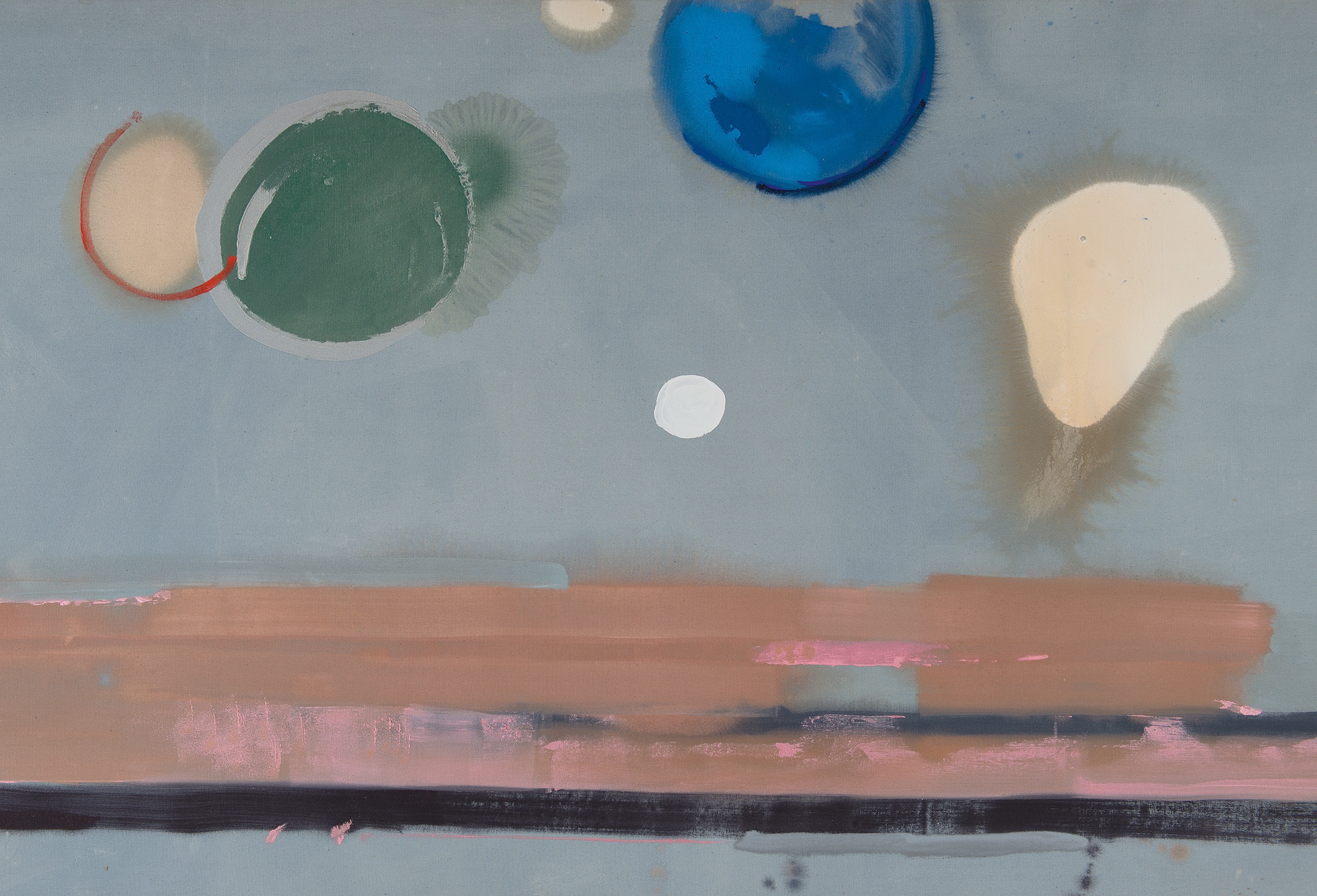





15
Helen Frankenthaler
Scorpio
signed ’Frankenthaler‘ lower right; further titled and dated '"SCORPIO" 1987' on the reverse
acrylic on canvas
235.5 x 333.5 cm. (92 3/4 x 131 1/4 in.)
Painted in 1987.
Full-Cataloguing
Helen Frankenthaler was an American second-generation Abstract Expressionist painter, whose practice was crucial to the development of the Colour Field movement. Active for over six decades, she spanned several generations of abstract painters while continuing to produce vital and ever-changing new work, gaining particular critical acclaim for her pioneering use of the “soak-staining” technique in oil painting.
Graduating from college with a Cubist-derived style, Frankenthaler encountered the work of the iconic Abstract Expressionist Jackson Pollock in 1950. Seeing Pollock's radical drip paintings Autumn Rhythm, Number 30, 1950 and Number One, 1950 (Lavender Mist) was a coup de foudre for the young artist: "It was all there. I wanted to live in this land. I had to live there, and master the language." (the artist quoted in Alison Rowley, Helen Frankenthaler: Painting History, Writing Painting, London, 2007, p.1)
Frankenthaler began working on and exhibiting large-scale Abstract Expressionist paintings in the early 1950s, and was included in the seminal 1964 Post-Painterly Abstraction exhibition curated by the legendary art critic Clement Greenberg. Frankenthaler's work was introduced as part of a newer, more progressive generation of Abstract Expressionist painting championed by Greenberg that came to be known as Colour Field, characterised by the application of large areas of a single colour to the canvas. Although they shared the same large formats and simplified compositions as the Action Painters, Colour Field artists (including Barnett Newman and Mark Rothko) were distinguished by their efforts to escape all increasingly imitative, academic qualities, including the inclusion of any emotional, mythic and religious content or gestural qualities.
Pursuing a purer abstract form of Colour Field painting, Frankenthaler's work is associated with the use of fluid, organic shapes and vast, simplified abstract compositions created on canvas directly laid down on the floor with the “soak stain” technique which she invented in 1952. With this technique, she allowed the pigment poured onto the canvas to slowly become absorbed into its fibres. Permitting gravity and chance to steer the direction of her painting, Frankenthaler enjoyed the contemplative gratification of watching the diluted paint dissolve into thin, almost ethereal, skeins of pigment. It was a startling innovation at the time, with Clement Greenberg inviting fellow artists Morris Louis and Kenneth Noland to visit Frankenthaler's studio to witness her methods in action.
By the early 1980s, Frankenthaler had amplified her painterly approach and readjusted her pictorial vocabulary: she laid down monochromatic fields of atmospheric colour and superimposed a scatter of dabs, dots, and dashes of more tangible pigment, or floating islands of colour and calligraphic lines, as seen in Madrid (1984). By the latter part of that decade she was consolidating various elements of previous work to create her pictures. Scorpio is a prime example of works from this period. In this painting, we see the artist’s intention to create the illusion of spatial depth via the expanse of a flat surface divided into ribbons of pure colour. To the pouring of liquid on the canvas she also adds elements of dripping and serpentine lines lightly trailed with a brush, like the tail of the titular Scorpio. Within those delimitations, she creates an imaginary landscape in which the sand leads towards a calm sea, set against a beautiful sky streaked with shades of blue and grey. Clouds emerge from the parts of the canvas untouched by the poured pigment. A few bubbles rise like balloons into the sky, adding splashes of colour to the composition. Her technique, although extraordinarily refined, renders an inner vision onto canvas with perfect spontaneity and improvisation.
"A really good picture looks as if it's happened at once. It's an immediate image. For my own work, when a picture looks labored and overworked, and you can read in it—well, she did this and then she did that, and then she did that—there is something in it that has not got to do with beautiful art to me. And I usually throw these out, though I think very often it takes ten of those over-labored efforts to produce one really beautiful wrist motion that is synchronized with your head and heart, and you have it, and therefore it looks as if it were born in a minute." (the artist quoted in Barbara Rose, Frankenthaler, New York, 1975, p. 85)
Scorpio was recently featured in an exhibition at the Clark Art Institute in Williamstown (2017), in which some of Frankenthaler’s paintings and woodcuts were reassessed in light of her relationship with nature. The New York artist was indeed influenced both by nature and the tradition of landscape painting, particularly by the paintings of J.M.W. Turner and Gustave Courbet. Alexandra Schwartz, the exhibition’s guest curator, highlighted the fact that many of Frankenthaler’s works were inspired by her surroundings, and that she used a number of cues from the natural world — preliminary outdoor sketches, earth tones, textured layers of paint — to create her abstract canvases. Using horizontal lines across her canvases, just as traditional landscape painters did, she adopted forms of nature — trees, clouds, cliffs and specific colours — that she reimagined in the abstract (quoted in Steve Pfarrer, '"There are no rules:" Clark Art Institute features work of Helen Frankenthaler', Amherst Bulletin, 24 August 2017, online). Another important source of inspiration for Frankenthaler came from the watercolours of Paul Cézanne, whose light plein-air studies were key to liberating his oil paintings from over-academic formalism (see for example Montagne Sainte Victoire, 1905-6). To achieve the right effect, Frankenthaler painted directly onto untreated canvas with oil paints heavily diluted with turpentine. Her "soak stain" technique allowed colours to penetrate immediately into the canvas, creating a diffuse, translucent effect reminiscent of watercolour.
Frankenthaler’s thinking paralleled that of great Asian modern masters such as Chu Teh-Chun (see for example lot 13), Zao Wou-ki and Zhang Daqian. Using diluted ink wash-like oils, these artists created sweeping painterly surfaces emulating natural movement. Zhang in particular, one of the most renowned and prodigious Chinese artists of the twentieth century who prefigured the journey of many of Chinese painters from guohua (traditionalist) painting to modern expressionism, combined his training across the cultures of the East and West to create expressionist masterpieces reminiscent of Tang Dynasty splashed-ink paintings, its spontaneity mirroring the divine process of creation (see for example The Swiss Snow Mountain (1965).
Frankenthaler’s work has been the subject of several major exhibitions and retrospective until now, including at the Whitney Museum of American Art, New York (1969), the Museum of Modern Art, New York (1989), the Solomon R. Guggenheim Museum, New York (1998) and the Albright-Knox Art Gallery, Buffalo, New York (2015). The latest exhibition staged in 2019 in Italy (Pittura/Panorama Paintings by Helen Frankenthaler 1952-1992) signaled the return of the artist to Venice, the first exhibition of the artist in this city since her first appearance in 1966 at the American Pavilion of the 33rd Biennale.
Graduating from college with a Cubist-derived style, Frankenthaler encountered the work of the iconic Abstract Expressionist Jackson Pollock in 1950. Seeing Pollock's radical drip paintings Autumn Rhythm, Number 30, 1950 and Number One, 1950 (Lavender Mist) was a coup de foudre for the young artist: "It was all there. I wanted to live in this land. I had to live there, and master the language." (the artist quoted in Alison Rowley, Helen Frankenthaler: Painting History, Writing Painting, London, 2007, p.1)
Frankenthaler began working on and exhibiting large-scale Abstract Expressionist paintings in the early 1950s, and was included in the seminal 1964 Post-Painterly Abstraction exhibition curated by the legendary art critic Clement Greenberg. Frankenthaler's work was introduced as part of a newer, more progressive generation of Abstract Expressionist painting championed by Greenberg that came to be known as Colour Field, characterised by the application of large areas of a single colour to the canvas. Although they shared the same large formats and simplified compositions as the Action Painters, Colour Field artists (including Barnett Newman and Mark Rothko) were distinguished by their efforts to escape all increasingly imitative, academic qualities, including the inclusion of any emotional, mythic and religious content or gestural qualities.
Pursuing a purer abstract form of Colour Field painting, Frankenthaler's work is associated with the use of fluid, organic shapes and vast, simplified abstract compositions created on canvas directly laid down on the floor with the “soak stain” technique which she invented in 1952. With this technique, she allowed the pigment poured onto the canvas to slowly become absorbed into its fibres. Permitting gravity and chance to steer the direction of her painting, Frankenthaler enjoyed the contemplative gratification of watching the diluted paint dissolve into thin, almost ethereal, skeins of pigment. It was a startling innovation at the time, with Clement Greenberg inviting fellow artists Morris Louis and Kenneth Noland to visit Frankenthaler's studio to witness her methods in action.
By the early 1980s, Frankenthaler had amplified her painterly approach and readjusted her pictorial vocabulary: she laid down monochromatic fields of atmospheric colour and superimposed a scatter of dabs, dots, and dashes of more tangible pigment, or floating islands of colour and calligraphic lines, as seen in Madrid (1984). By the latter part of that decade she was consolidating various elements of previous work to create her pictures. Scorpio is a prime example of works from this period. In this painting, we see the artist’s intention to create the illusion of spatial depth via the expanse of a flat surface divided into ribbons of pure colour. To the pouring of liquid on the canvas she also adds elements of dripping and serpentine lines lightly trailed with a brush, like the tail of the titular Scorpio. Within those delimitations, she creates an imaginary landscape in which the sand leads towards a calm sea, set against a beautiful sky streaked with shades of blue and grey. Clouds emerge from the parts of the canvas untouched by the poured pigment. A few bubbles rise like balloons into the sky, adding splashes of colour to the composition. Her technique, although extraordinarily refined, renders an inner vision onto canvas with perfect spontaneity and improvisation.
"A really good picture looks as if it's happened at once. It's an immediate image. For my own work, when a picture looks labored and overworked, and you can read in it—well, she did this and then she did that, and then she did that—there is something in it that has not got to do with beautiful art to me. And I usually throw these out, though I think very often it takes ten of those over-labored efforts to produce one really beautiful wrist motion that is synchronized with your head and heart, and you have it, and therefore it looks as if it were born in a minute." (the artist quoted in Barbara Rose, Frankenthaler, New York, 1975, p. 85)
Scorpio was recently featured in an exhibition at the Clark Art Institute in Williamstown (2017), in which some of Frankenthaler’s paintings and woodcuts were reassessed in light of her relationship with nature. The New York artist was indeed influenced both by nature and the tradition of landscape painting, particularly by the paintings of J.M.W. Turner and Gustave Courbet. Alexandra Schwartz, the exhibition’s guest curator, highlighted the fact that many of Frankenthaler’s works were inspired by her surroundings, and that she used a number of cues from the natural world — preliminary outdoor sketches, earth tones, textured layers of paint — to create her abstract canvases. Using horizontal lines across her canvases, just as traditional landscape painters did, she adopted forms of nature — trees, clouds, cliffs and specific colours — that she reimagined in the abstract (quoted in Steve Pfarrer, '"There are no rules:" Clark Art Institute features work of Helen Frankenthaler', Amherst Bulletin, 24 August 2017, online). Another important source of inspiration for Frankenthaler came from the watercolours of Paul Cézanne, whose light plein-air studies were key to liberating his oil paintings from over-academic formalism (see for example Montagne Sainte Victoire, 1905-6). To achieve the right effect, Frankenthaler painted directly onto untreated canvas with oil paints heavily diluted with turpentine. Her "soak stain" technique allowed colours to penetrate immediately into the canvas, creating a diffuse, translucent effect reminiscent of watercolour.
Frankenthaler’s thinking paralleled that of great Asian modern masters such as Chu Teh-Chun (see for example lot 13), Zao Wou-ki and Zhang Daqian. Using diluted ink wash-like oils, these artists created sweeping painterly surfaces emulating natural movement. Zhang in particular, one of the most renowned and prodigious Chinese artists of the twentieth century who prefigured the journey of many of Chinese painters from guohua (traditionalist) painting to modern expressionism, combined his training across the cultures of the East and West to create expressionist masterpieces reminiscent of Tang Dynasty splashed-ink paintings, its spontaneity mirroring the divine process of creation (see for example The Swiss Snow Mountain (1965).
Frankenthaler’s work has been the subject of several major exhibitions and retrospective until now, including at the Whitney Museum of American Art, New York (1969), the Museum of Modern Art, New York (1989), the Solomon R. Guggenheim Museum, New York (1998) and the Albright-Knox Art Gallery, Buffalo, New York (2015). The latest exhibition staged in 2019 in Italy (Pittura/Panorama Paintings by Helen Frankenthaler 1952-1992) signaled the return of the artist to Venice, the first exhibition of the artist in this city since her first appearance in 1966 at the American Pavilion of the 33rd Biennale.